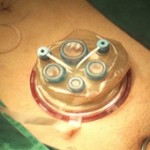Step-by-Step: Ultra-mini percutaneous nephrolithotomy (UMP): one more armamentarium
Ultra-mini percutaneous nephrolithotomy (UMP): one more armamentarium
Janak Desai and Ronak Solanki
Department of Urology, Samved Hospital, Ahmedabad, India
OBJECTIVE
• To describe our newly developed technique for the removal of renal stones, which we have called ultra-mini percutaneous nephrolithotomy (UMP).
METHODS
• UMP was performed in 62 patients using a 3.5-F ultra-thin telescope and specially designed inner and outer sheaths. A standard puncture was made and the tract was dilated up to 13 F.
• The outer sheath was introduced into the pelvicalyceal system and the stone was disintegrated with a 365-μ holmium laser fibre, introduced through the inner sheath.
• Stone fragments were evacuated using the specially designed sheath by creating an eddy current of saline; the fragments then came out automatically.
RESULTS
• The mean calculus size was 16.8 mm. Four of the 62 patients were children, three had a solitary kidney and two were obese.
• UMP was feasible in all cases with a mean (sd) 1.4 (1.0) gm/dL haemoglobin decrease and a mean hospital stay of 1.2 (0.8) days. The stone-free rate at 1 month was 86.66%.
• In two patients intraoperative bleeding obscured vision, requiring conversion to mini-percutaneous nephrolithotomy. There was one postoperative complication of hydrothorax, but there were no other postoperative complications and no auxiliary procedures were required.
CONCLUSIONS
• UMP is a very safe and effective method of removing renal calculi up to 20 mm. The use of consumables and disposables is minimal and the patient recovery was fast.
• Further clinical studies and direct comparison with other available techniques are required to define the place of UMP in the treatment of low-bulk and medium-bulk renal urolithiasis. It may be particularly useful for lower calyx calculi and paediatric cases.




UMP is excellent minimally invasive technique. It has advantages of minimal blood lass, single treatment ( no DJ stent), less hospitalization & good stone clearance.I have seen many times Dr. Janak Desai performing UMP. UMP will be more & more useful in future.
Excellent! Nicely performed.This procedure will certainly be accepted for stones up to 2 cm size because of minimal invasive nature and minimum scope for renal trauma.is it a repalcement to mini pcnl? only time will tell.Pcnl though established procedure for the management of moderate to large renal stone,art of puncture remains challenge.
The video demonstrates well the simplicity and the minimal invasiveness of the procedure. It appears to overcome the need for expensive disposables that is often the case in flexible uretero -renoscopy. I agree that once the learning curve is overcome, an evaluation comparing the the technique to retrograde intrarenal surgery will give us insight to where in the endo- urologist’s armamentarium this technique will lie.
UMP , I think this is another milestone in history of Urolog. However further Studies would be required to conclude.So let’s see otherwise its sounds nice. Its further minimally invasive and beneficial for the patients.